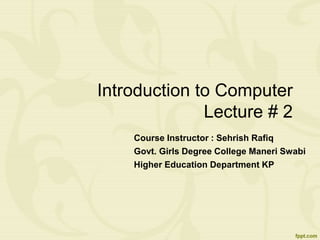
Introduction to Computers Lecture # 2
- 1. Introduction to Computer Lecture # 2 Course Instructor : Sehrish Rafiq Govt. Girls Degree College Maneri Swabi Higher Education Department KP
- 2. Lecture overview • Human Vs.Computer • History of Computer • Generations of Computer
- 3. Human Vs. Computer S . No Human Computer 1. Perform numeric computations Perform numeric computations at very faster speed than humans 2. Creative Feeded 3. Remembers or write information Stores huge amount of Information for long term as compared to humans 4. Gets tired and bored of repetitive activity Best in performing repetitive operations 5. Common sense based judgment Does not have any sense 6. Best in pattern matching than computers Slow in pattern matching and cognition
- 4. History of computer Era Inventor Method / Device Structure Features 2400 BC Ancient Chinese Abacus String of beads Calculation 1617 John Napier Napier Bones Mechanical Rods made of bones Long computations Fast Accurate 1642 Blaise Pascal Pascaline Mechanical Wheels & Gears Addition Subtraction Carry feature 1694 Gottfried Leibnitz Stepped Reckoner Digital Machine based on binary numbers Multiplication Division 1830 Charles Babbage Analytical Engine Programmable Computer Input section(Punched cards) Print Unit Control unit( operating computer) Mill unit(Calculations) Store( numbers storage)
- 5. Historical Devices Abacus Pascaline Inner ViewPascaline Outer View Napier Bones Stepped Reckoner
- 6. Historical Devices Punched card Punched card writer Punched card Reader Jacquard loom Jacquard punched card
- 7. Continued… Era Inventor Method / Device Structure Features 1886 William Burroughs Adding machine Mechanical in nature Commercial use 1890 Dr. Herman Hollerith Electro-Mechanical Punched Card Tabulator Electro-Mechanical Card-Programmed 1930 Bush Differential Analyzer Analog computer - 1944 H. Aiken Mark I Electro-Mechanical Relays instead of gears Digital 1946 JW Mauchly & JP Eckert ENAIC Electronic Vacuum tubes For Military Digital Tremendous heat Large amount of electricity(150 KW) weight>30 tons Area :167 sq m 6 people for programming
- 8. Electronic Components Relay switch Vacuum Tube Half Adder Transistors Integrated Circuit (IC)
- 9. Historical Devices ENAIC Computer Herman’s Punched Card Tabulator Differential Analyzer Mark-I Burrough’s Adding Machine
- 10. Continued… Era Inventor Method / Device Structure Features 1951 Sperry Rand UNIVAC( UNIVersal Automatic Computer )-I Elastic Magnetic tape Commercial 1953 MIT Whirl Wind-I Electrical Transistors instead of vacuum tubes 1965 Digital Equipment Corporation (DEC) PDP-8 Minicomputer Electrical ICs 1975 MITS Altair 8800 Microcomputer -
- 11. Historical Devices UNIVAC-I Whirl Wind-I 1st Mini-Computer Altair 8800
- 12. Generations of Computer • Generation in computer science terminology is a step in technology. • It provides a framework for the growth of computer industry. • It is used to distinguish between various hardware and software technologies. • Till today there are five computer generations.
- 13. Generations of computer Generation (Period) Hardware Technologies Software Technologies Characteristics Systems 1st (1942-1955) Vaccume tubes Electro-magnetic relay memory Punched cards Machine Language Assembly language Stored Program concept Scientific applications Bulky in size Expensive Unreliable Limited commercial production and use ENAIC EDVAC EDSAC UNIVAC-I IBM 701 2nd (1955-1964) Transistors Magnetic core memory Magnetic tapes Disks Batch OS High-Level languages Scientific & commercial applications Faster Smaller Easier to program Difficult commercial production Expensive Honeywell- 400 IBM 7030 CDC-1604 UNIVAC Larc 3rd (1964- 1975) ICs with SSI and MSI Larger capacity magnetic disks and magnetic tapes Mini computers Timesharing OS Multiprogramming Smaller Faster Easier and cheaper to produce Easier to upgrade than previous generation IBM 360/370 PDP-8 PDP-11 CDC-6600
- 14. Continued… Generation (Period) Hardware Technologies Software Technologies Characteristics Systems 4th (1975-1980) ICs with VLSI Larger capacity hard disks Magnetic tapes and floppy disks Personal Computers Mainframe computers Super computers Computer Networks GUI based OS for PCs Multiprocessing UNIX OS with C Object Oriented Languages Network based applications Small Affordable Reliable Easy to use General purpose Easy to upgrade IBM PC Apple-II TRS-80 VAX-9000 5th (1980- present) ICs with ULSI Larger main memory Hard disks with RAID support Optical Disks Notebooks Laptops Powerful server computers Advanced super computers Internet Multi-threading Distributed OS Multimedia applications Internet applications Portable Powerful Cheaper Reliable General purpose Commercially feasible Easy to upgrade Rapid software development IBM Notebooks Sun systems Dell and hp Laptops Android Mobiles Tablets
